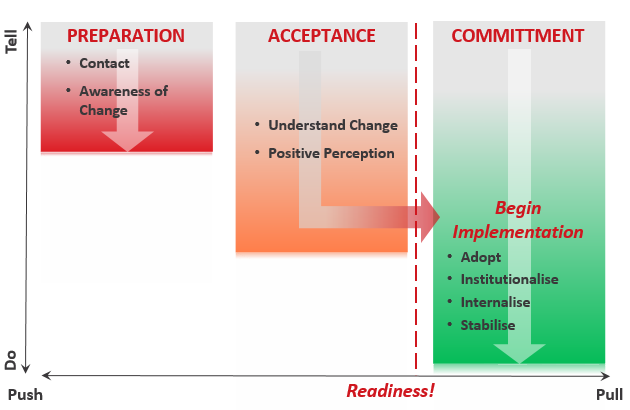We (OTM) are often asked if we can help with the implementation of a design that has either been done by an in-house team, or more commonly, has been completed by a third party at the behest of the Leadership Team.
When should implementation begin?
Very rarely is the organization anywhere near ready to make the change to working in the envisioned new way. For us, there are two very basic tests of an organization’s change readiness:
-png.png)
If there is not complete alignment around the answer being yes to both questions, then there is more design or change readiness work to be done.

Is the technical design complete?
On the surface this should be a very simple question to answer: the technical design is either complete or it isn’t, there is no halfway house. However, organizations often want to try and implement an incomplete design. Having an organization chart with names against some senior leadership jobs and an outdated RACI matrix does not constitute a complete design. All it tells everyone is who reports to who and that a few lucky leaders have jobs in the future state.
For the technical design to be ready to implement a series of conditions must be met across three critical areas.
1. Structure: An organization chart is just one component part the future structure. Structure defines how boundaries are drawn around work in the new design.-png.png)
-
- First this happens at a departmental and/or functions level where it becomes clear what work is done where and how customer-value creating work flows end-to-end in the operating model.
- At the next level, structure defines the teams within the departments and/or functions, the work of the teams and the boundaries between teams.
- Finally, structure defines the jobs within teams and the level of work done by each job.
Therefore, the first completeness test of a technical design looks for work in boundaries at department and/or function, team, and individual job level. Some white space may have been left at the job level within teams to allow individuals to make the jobs their own during the implementation phase.
2. Management Operating System: A complete structure cannot be implemented without a clearly defined Management Operating System. Every structure needs to be kept aligned both horizontally and vertically using systems, processes, mechanisms and roles.
The horizontal element ensures that as work passes from person-to-person, team-to-team, department-to-department and function-to-function, it:
-png.png)
The vertical element ensures that day-to-day work remains aligned to the business strategy and goals as the business responds to macro-changes in the business environment.
The Management Operating System defines where and how decisions are made and the ways-of-working within the structure. Therefore, the second completeness test of the technical design looks for horizontal and vertical alignment mechanisms, the role of individuals within those mechanisms, and the ways-of-working.
3. Information Systems: The best Management Operating System cannot operate without the right information being available in the right place at, the right time. Speed and accuracy of decisions are critically dependent on this information being available. Therefore, the final completeness test of the technical design looks for clearly articulated information flows and well-defined Information Systems/Technology requirements down to an individual level.
On any of the three completeness tests we would not expect to see everything 100% finalized. There always needs to be some freedom for people to make the jobs their own within a clearly defined set of parameters and constraints during the implementation phase. Although most of the detail design (roughly 75%) is completed before implementation, the remaining 25% occurs during this phase. Doing so provides white-space for teams and individuals to make the jobs their own throughout the implementation process.
However, we would expect that all three areas have been comprehensively addressed with most other components of the new operating model close to complete; any less suggests that more detail design work is needed. If you are satisfied that the technical design is sufficiently complete and ready for implementation, then it should also be more-or-less true that:
-png.png)
Only then is it time to move on and look at the social system.
Is the social system ready?
Like technical design completeness, the social system is either ready to begin working in a new way or it isn’t – again there is no halfway house. However, this does not seem to stop organizations trying to push implementation onto a social system that isn’t ready.
Conner and Patterson’s work on ‘The Commitment Curve’ and Ackerman’s work on the depth of change (see below) are our guides here. We know that for successful implementation to happen, the whole of the social system should first have been through a ‘Preparation Phase.’ This means that people have both heard about the new design and are aware of its impact. Following the Preparation Phase they should also have passed through an ‘Acceptance Phase.’ This phase affords people the opportunity, ideally through involvement in the process, to understand what the new design really means for both the organization as a whole and for them as individuals, and for them to have developed a positive perception towards the change. Before people begin to work in new ways they need to have accepted the change, have a positive perception towards it, and be pulling for it. At ON THE MARK we call this achieving “readiness.” Implementation must not start before psychological readiness exists in the affected parts of the business.

Reviewing the design process that has been used and the breadth and depth of involvement across the organization will give you clues to social system readiness. Assessing the level of leadership alignment around the new design will give you further clues – a leadership team that is not aligned should set off major alarm bells!

Finally, nothing beats going out into the organization and judging for yourself through informal conversations, focus groups, interviews and/or questionnaires, how ready people are for the proposed change.
Next steps.
Ideally you would assess the technical system for completeness, the social system for readiness, and find both a complete technical design and an implementation-ready social system. This would allow you to lay your implementation plans and begin implementation. However, this is rarely the case. Sometimes there are gaps in the technical design, sometimes there are areas of the social system that are not ready, and often both.
This is not a case for despair, merely an indication that before new ways of working can begin there is a need to plan for some ‘transition’ work. In order to do so, the transition plan has to ready the social system for change by involving them in the work that needs to be done to complete the technical design. This ensures that implementation of a complete design can begin in a social system that is ready for change.
An incomplete technical design and/or a social system that is not ready for change are clear indicators that your implementation will not be successful. An investment in transition planning will pay huge dividends later down the line.
Peter Turgoose was a Senior Consultant at ON THE MARK.
OTM is the leading global boutique organization design consultancy with offices in the USA and UK. With over 400 successful redesigns and operating model modernizations completed, OTM is owner of the industry’s most integrated, comprehensive and holistic organization design solution. OTM enables its clients to realize their future ambitions.


